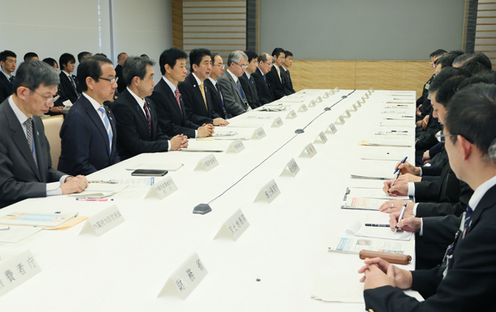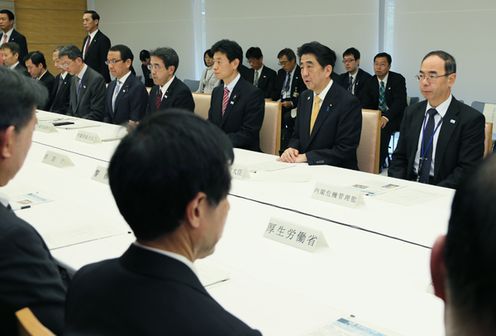Home > News > The Prime Minister in Action > November 2014 > Meeting for the Drill to Establish Emergency Disaster Response Headquarters and Tsunami Disaster Prevention
Meeting for the Drill to Establish Emergency Disaster Response Headquarters and Tsunami Disaster Prevention
Wednesday, November 5, 2014

Photograph of the Prime Minister delivering an address (1)

Photograph of the Prime Minister delivering an address (2)

Photograph of the Prime Minister delivering an address (3)
Prime Minister Shinzo Abe attended the Meeting for the Drill to Establish Emergency Disaster Response Headquarters and Tsunami Disaster Prevention, held on Tsunami Disaster Prevention Day (November 5) at the Prime Minister’s Office, and gave an address.
The large-scale tsunami accompanying the Great East Japan Earthquake in 2011 destroyed many precious human lives, particularly along the Pacific coast in the Tohoku region.
In the wake of this, in June of that year the Act on the Promotion of Tsunami Countermeasures was enacted, establishing November 5 as the annual “Tsunami Disaster Prevention Day.” It was decided that efforts would be made on this day to widely promote understanding and interest in tsunami countermeasures among the public.
During the meeting, there were reports on initiatives and the situation related to Tsunami Disaster Prevention Day, as well as drills on earthquake and tsunami disaster prevention occurring in every region.
Following the reports on drills, the Prime Minister said in his address,
“I would like to offer some remarks upon the drill to establish emergency disaster response headquarters during Tsunami Disaster Prevention Day.
Just now, we received a report from State Minister Nishimura. It is of great significance that earthquake and tsunami disaster prevention drills are taking place in every region with the participation of residents today, on Tsunami Disaster Prevention Day.
Many lives were destroyed by the tsunami during the Great East Japan Earthquake. According to damage predictions, in the worst possible situation, it has been calculated that the tsunami from an earthquake in the Nankai Trough could cause as many as 230,000 deaths.
Building on the previous lessons learned from the Great East Japan Earthquake and at other times, the Government is constantly preparing for future tsunami disasters and reconsidering disaster prevention countermeasures from both hard and soft infrastructure perspectives.
Because this is an natural disaster that could happen suddenly, the most important thing to protect lives is preparedness and preparation for disasters by each and every member of the public.
At the time of the Great East Japan Earthquake, there were cases, such as what came to be called the ‘Miracle of Kamaishi,’ in which the lives of many children were saved thanks to daily disaster prevention education and evacuation drills. These experiences of people saving their own lives from the tsunami are precious lessons, and it is important that they be shared and passed down to future generations without becoming diluted.
In that sense, the initiatives for disaster prevention to have drills and other events occur throughout Japan every year in every region on Tsunami Disaster Prevention Day, bringing together the Government, municipal governments, private sector companies, and the public, are extremely important.
I would like to conclude my remarks by expressing the hope that everyone continue to utilize their creativity and ingenuity to undertake initiatives that will protect lives. Thank you.”


